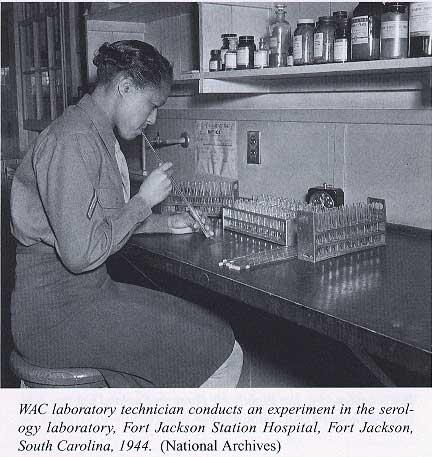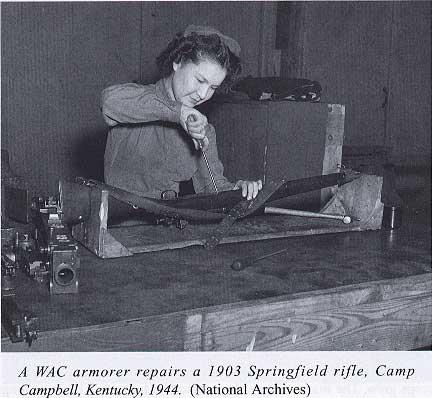WAACs assigned to the Corps of Engineers participated in the Manhattan Project. M. Sgt. Elizabeth Wilson of the Chemistry Division at Los Alamos, New Mexico, ran the cyclotron, used in fundamental experiments in connection with the atomic bomb. WAAC Jane Heydorn trained as an electronics construction technician and, as part of the Electronic Laboratory Group at Los Alamos, was involved in the construction of the electronic equipment necessary to develop, test, and produce the atomic bomb. WAACs at the Oak Ridge, Tennessee, site maintained the top secret files related to the project, working twelve-hour shifts seven days a week. Other WAACs involved in the Manhattan Project included three women assigned to the Corps of Engineers in London, who helped to coordinate the flow of information between English and American scientists cooperating on the project.
The Army Ground Forces were initially reluctant to request and employ WAACs. The AGF eventually received 20 percent of all WAAC assignments. Many high-ranking staff officers would have preferred to see women aid the defense effort by taking positions in industry. A report prepared by the Plans Section, AGF, reflected this attitude: "In industry it is necessary to train personnel in only a single operation on the production line. Military duties require a versatility that is acquired only by long experience." As a result, WAACs assigned to Army Ground Forces often felt unwelcome and complained of the intensive discipline imposed upon them. Most AGF WAACs worked in training centers where 75 percent performed routine office work. Another 10 percent worked in motor pools. AGF WAACs found that chances for transfer and promotion were extremely limited, and many women served throughout the war at the posts to which they were initially assigned. The stories of Ground Forces WAACs contrasted sharply with those of women assigned to the Air and Service Forces, who were routinely sent to specialist schools and often transferred between stations.
Women's Army Corps members served worldwide-in North Africa, the Mediterranean, Europe, the Southwest Pacific, China, India, Burma, and the Middle East. Overseas assignments were highly coveted, even though the vast majority consisted of the clerical and communications jobs at which women were believed to be most efficient. Only the most highly qualified women received overseas assignments. Some women turned down the chance to attend Officer Candidate School in favor of an overseas assignment.
The invasion of North Africa was only five days old when, on 13 November 1942, Lt. Gen. Dwight D. Eisenhower asked that five WAAC officers, two of whom could speak French, be sent immediately to Allied Force Headquarters to serve as executive secretaries. The ship carrying Third Officers Martha Rogers, Mattie Pinette, Ruth Briggs, Alene Drezmal, and Louise Anderson was torpedoed en route from Great Britain to Algiers. A British destroyer plucked two of the women from the burning deck of their sinking ship. The other three escaped in a lifeboat. While adrift on the high seas, they saved several seamen by pulling them into the boat with them. Picked up by a destroyer, they were delivered to Algiers with no uniforms, clothing, or supplies. The women were greeted by anxious officers with gifts of oranges and toiletries.

These five women served on General Eisenhower's staff successively throughout the North African, Mediterranean, and European campaigns. In 1945 Eisenhower stated, "During the time I have had WACs under my command they have met every test and task assigned to them... their contributions in efficiency, skill, spirit and determination are immeasurable."
The first WAAC unit overseas, the 149th Post Headquarters Company, reported on 27 January 1943 to General Eisenhower's headquarters in Algiers. Initially unit members were housed in the dormitory of a convent school and transported to and from the headquarters in trucks. They served as postal workers, clerks, typists, and switchboard operators. Nightly bombings and accompanying antiaircraft fire made sleep difficult for the first few weeks, but most of the women acclimated fairly quickly. Additional WAAC postal workers joined them in May. A WAAC signal company arrived in November to take jobs as high-speed radio operators, teletypists, cryptographic code clerks, and tape cutters in radio rooms. Corps members assigned to the Army Air Forces arrived in North Africa in November 1943 and January 1944.

One of the most famous WAAC/WAC units to serve in the North African and Mediterranean theaters was the 6669th Headquarters Platoon, assigned to Lt. Gen. Mark W. Clark's Fifth Army. This unit became the Army's "experiment" in the use of female units in the field. The 6669th accompanied Fifth Army headquarters from Mostaganem, Algeria, across the Mediterranean to Naples and eventually all the way up the boot of Italy. Unit members remained from six to thirteen miles behind the front lines, moved with the headquarters group, and worked in traditional female skills. The unit's table of organization called for 10 telephone operators, 7 clerks, 16 clerk-typists, 10 stenographers, and 1 administrative clerk. Even so, these jobs had a vastly different flavor from traditional employment in the United States. WAAC telephone operators were required to get through extremely complicated communications networks to reach within minutes the commanding officer of any unit sought by General Clark. Clerk-typists plotted the locations and movements of the troops and requisitioned and tracked the delivery of crucial supplies. Clark and his staff treated the WAACs as valued members of the Fifth Army team, and the women responded by submitting to the hardships associated with forward troop movements with little complaint.
The WAACs' success in the North African and Mediterranean theaters led to an increasing number of requests for WAACs from overseas theaters. Before the War Department could honor these requests, however, it had to find a solution to a more immediate problem. In early 1943 the number of women joining the WAAC dropped drastically due to a sudden backlash of public opinion against the employment of women in the armed forces.
Questions and Activities
- Briefly describe the main functions of this branch of the military.
- Explain why women were so pivotal in these capacities.